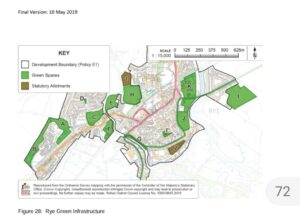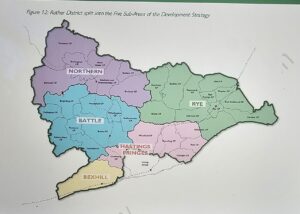With consultation until late July on the Rother District Local Plan, discussions have been continuing at Rye Town Council to make sure the Rye Neighbourhood plan is reflected in what is finally published.
Last month a team from Rye, including the mayor and councillors, met senior members of Rother District Council’s planning department to press home the view from Rye. Discussions have also been focussed on how a change in government might affect development in Rye.
The current government policy, which emerged from end of 2023 in the Levelling Up and Regeneration Act 2023 (the Act), aims “to incentivise the prompt build-out of housing sites and to support councils in acting against those who fail to meet these commitments”.
Labour pledges to overhaul planning laws, which it has claimed “act as a major brake on economic growth”. The party says it would build 1.5 million new homes over the next five-year parliament, restoring mandatory housing targets and “making full use of intervention powers to build the houses we need”. Labour’s plans “will enhance local communities power and voice over ‘how’ housing is built to best service local people, while challenging those who question ‘if’ homes the people need should be built at all.”
Work continues during government uncertainty until the outcome of the election on July 4, is known, meanwhile the consultation on the Rother District Plan is open until July 23. You can find out more here.
How does all this affect Rye?

Importantly, Rye retains its Neighbourhood (Development) Plan, which is a statutory planning document, approved by local referendum in 2019. This enables Rye Town Council to influence strategic planning and development across Rye.
However, for areas like Rye, with its own plan, Rother does not identify or allocate development sites, as Rye has already done that. Rother does set all the other overarching planning policy, such as for climate change, (now called “Green to the Core”) and the necessary social services (now called “Live Well Locally”).
The Rye Neighbourhood Plan Steering Group has remained engaged with Rother Planners since mid 2023, with a view to assessing what change might be necessary to ensure that Rye Plan remains relevant and in step with higher policy. What has emerged from the work is that some aspects of the Rye Plan may need strengthening to reflect the need for social housing (and to achieve it), policy to deal with climate change, and the vital infrastructure needed for the future. It might be that rather than Rye designing it’s own measures stronger links are made to Rother policy to avoid duplication.
The Emerging Rother Local Plan – The Rye View
As part of the consultation on the Rother draft plan, the mayor of Rye and a team of councillors and citizens met with senior Rother planners on May 21.
This was a valuable meeting in that it allowed Rye to hear the latest views from Rother but also to represent the Rye view on local development and related issues. Key points from a lengthy meeting included:

Possible New spatial definitions for Rother. There could be 5 sub divisions in Rother District, with “Rye and the Eastern Settlements cluster” being one, rather than just “Rural Rother”.
Development Constraints in Rye: Rother acknowledged the severe constraints on development in Rye, such as all types of flood risk, land instability, bio diversity protection and the “strategic gap” between Rye and Rye Harbour. Rye explained that the development or settlement boundary reflected these constraints.
Housing Targets: Rye confirmed that it had reviewed the latest numbers and considered that they could be met within the current allocation (identified sites) of the Neighbourhood Plan.
Social Housing and Second Homes/Airbnb: Rye asked what consideration there had been of the large number of “Buy to lets” and second homes, which distort the stock availability for first time buyers and local people on minimum wages. Rye suggested that as a minimum there should be registration to provide accurate data. Rother suggested that a study was under way.
Homes for the Elderly: Rye questioned the need for the number of such homes planned in the Winchelsea Road and Lower School Site schemes, when no affordable or social homes are included. The developers suggest that there would be “trickle down’ concept (older citizens releasing family homes in Rye to move to purpose built homes), but this was questioned. Some affordable homes for the latter site are now being reviewed following a further viability study. Rye underscored the need for social or affordable homes for young people on minimum wages.
Infrastructure: Rye underscored the need for enhanced vital infrastructure, particularly medical facilities to cope with an ageing population and a rise in the population because of new developments.
Green spaces: Rother suggested that any proposal for the green spaces listed in the Neighbourhood Plan to be better protected should be subject to further biodiversity assessment.
Other matters included planning enforcement, footpaths, parking and town centre issues.
Rye’s full response to the Rother Plan consultation has to be submitted by late July. The Rye Neighbourhood Plan Steering Group has divided up the 10 main Rother planning themes between members to focus on and provide comments. The latest on this work was reflected in the agenda for the Rye Planning and Townscape Meeting of 10 June and can be seen on the Rye Town Council Website.
Rother’s Call for Development Sites
As part of the Rother Local Plan process, it has to consider all potential development sites across the District including those identified in Neighbourhood Plans.
To this end in 2023, Rye Planners completed a strategic review of all the sites around Rye considered by owners and developers to have potential for development. This resulted in a comprehensive “Site Reassessment” which has been shared with Rother Planners. As a result, all the sites proposed by developers have been reassessed and categorised as “identified, potential or rejected” in the Rother Housing and Economic Land Availability Assessment (HELAA).
Many of the proposed sites have been initially rejected by Rother District. These are shown grey on the header map. You can find more on the government’s guidance on land assessment on this website.
The Rye View
Throughout all this work, Rye Town Council has underscored its determination to preserve the unique character of Rye, while delivering some social and open market housing and by improving policy to protect surrounding bio-diversity and landscapes, mitigate flood risk, implement climate change policy and improve infrastructure.
Consideration of all these issues takes place at the fortnightly Rye Planning and Townscape Committee and the periodic meetings of the Neighbourhood Plan Steering Group. To enable interested parties to keep up to date, records of all planning meetings can be found on the Rye Town Council website.
As work progresses we will report further. For anybody wishing to contribute to the work then please contact via the Rye Town Hall.
Image Credits: Rother District Council .




Rachel Reeves has this week announced mandatory housing targets and an end to the onshore wind ban to get “Britain building again”. The new Chancellor has set out some key measures:
Restore mandatory housebuilding targets but “Labour would not be increasing housebuilding by central decree”.
“It will still be, in the first instance, up to local communities and local authorities to decide where housing is built,” she said. But we will bring back mandatory targets so the answer cannot always be no.” This is reassuring for those areas with Neighbourhood Plans.
• Build 1.5m homes by the end of this parliament – including affordable and council homes
• End the onshore wind farm ban
• Create a new task force to accelerate stalled housing sites
• Support local authorities with 300 additional planning officers across the country (one per council?)
• Review planning applications previously turned down that could help the economy
• Prioritise brownfield and greybelt land for development to meet housing targets when needed
• Reform the planning system to “deliver the infrastructure that our country needs”
• Set out new policy intentions for critical infrastructure in the coming months.
Rother Planners have said that they are waiting for direction from the Deputy PM before any change is contemplated. Therefore what is set out in the piece is our current approach. As progress is made we will report further.